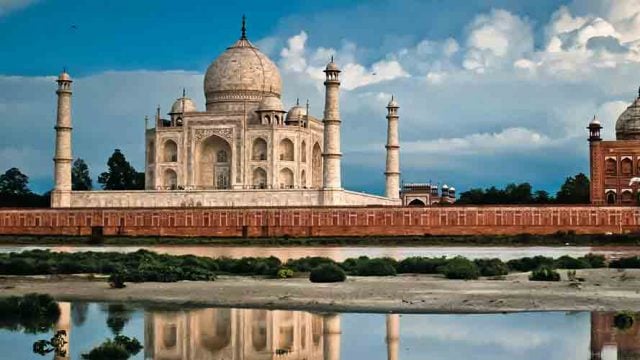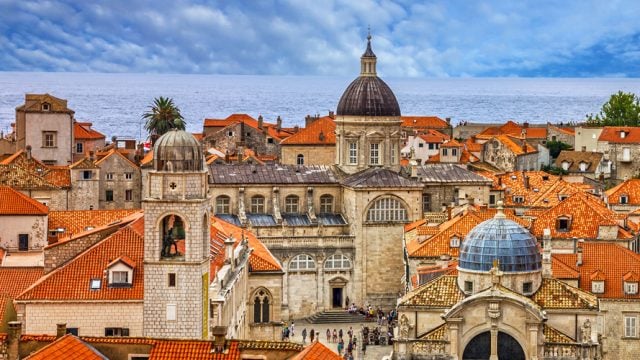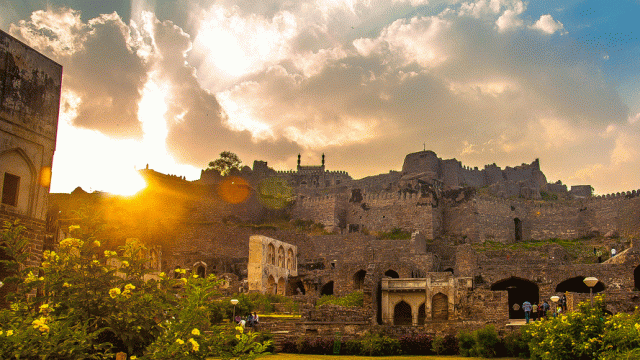As our car drove up the narrow road, the building took us by surprise. Was that a
Allowing the surprise to sink in, our expert tour guide, Shreyasi Bhattacharya, said, “This is the famous Hangsheswari Temple of Bansberia. Those pinnacles are lotus buds. The temple was built between 1801 and 1814. It was commissioned by King Nrisinghadev, who had studied tantric philosophy in Benares and designed the temple accordingly. It was completed by Rani Shankari, the younger of his two queens.”

This was the last stop on our day-long trip that had begun one pleasant September morning from Kolkata. The rains had washed the countryside of its grime. The lush green paddy fields, the brimming ponds and the occasional tufts of white kaash flowers reminded that autumn had arrived. With us was Bhattacharya, who was to help us explore some of the lesser known historical and architectural attractions of Hooghly district of West Bengal.
A mention of the kaash flowers, of course, always brings to mind the ever-popular Durga Puja. “Guptipara, the first destination we are headed to, is the place where the word baroyari originated,” said Bhattacharya. Today, the word baroyari is often used for the neighbourhood Durga Puja celebrations across Bengal. In Guptipara, literally 12 (‘baro’) friends (‘yaar’) had gotten together in the latter half of the 18th century to begin this particular tradition. It’s also the birth place of Bhola Moira, a sweetmeat manufacturer who was equally well known as a poet and a singer. Many even dub the local gupo sandesh as the first branded food from Bengal.
But what’s less known is that Guptipara is home to some beautiful terracotta temples from the 17th and 18th centuries that preserve Bengal’s old architectural style. The site is known as the Brindabanchandra Math, and it houses four separate Vaishnava temples—Chaitanya, Brindabanchandra, Ramchandra and Krishnachandra—built on connected stone platforms in the middle of a green expanse.

The Chaitanya temple, with wooden idols of Sri Chaitanya and Sri Nityananda, is said to be the oldest. The temple roof is built in the jor-bangla style, with two separate facades that look like thatched roofs, fused together. The 60-feet high Brindabanchandra Temple, which lends its name to the whole complex, is topped by Bengal’s at-chala (eight-sloped) roof style. The temple porch is covered in frescoes that bear a great similarity with Kalighat style of paintings. The individual frescoes are enclosed in frames, probably in a simulation of the panel style favoured in carved terracotta temples. Inside is an idol of Krishna playing the flute with his consort Radha. Behind the main deities are the three idols of Jagannath, Balabhadra and Subhadra.
The Rathayatra (chariot festival) of Guptipara is said to be one of the oldest chariot festivals in India, and attracts many local visitors, as well as Vaishnavas from the north-eastern states of the country. It is said that after the chariot festival of Puri, it is the chariot in Guptipara that covers the longest distance from the main temple to Krishna’s aunt’s house. The Brindabanchandra Temple is flanked by the Krishnachandra Temple and the Ramchandra Temple.
Topped by a single spire, or the ek-ratna style, the Ramchandra Temple is the one that’s the most sought after by art historians. We spend well over an hour going over its richly carved terracotta panels. Bhattacharya, a Ph.D in the coastal architecture of Bengal, drew our attention to individual panels that we might have missed otherwise. There were scenes from the Puranas and the Ramayana. There were snippets of contemporary social life, including royal processions, women playing musical instruments or dancing, royal hunting parties in action, as well as riverine and marine voyages. This temple really is a marvel. Compared to its architectural opulence, the Krishnachandra Temple, with its at-chala roof, is rather simple in appearance.
From Guptipara, we headed for Tribeni, about 30km away. But all the roaming and the knowledge had made us hungry and so we stopped at Tribeni market for lunch before moving to the Jafar Khan Ghazi mosque and dargah, maintained by the ASI and located on the bank of the Ganga. As we entered, to our right was the tomb of Jafar Khan Ghazi, a general in the Delhi Sultanate army. Devoid of any superstructure, the double-chambered tomb from 1315, made of basalt slabs, is the earliest extant mausoleum in eastern India, according to the ASI. The mosque was situated at the end of a path intersecting a sprawling green lawn.

Made of bricks and stone, the mosque, commissioned by Zafar Khan Ghazi, was built in 1298, according to an Arabic inscription above the mosque’s central mihrab. Five arches mark the entrance to the prayer hall, which is divided into two aisles by ornamental pillars. Three more decorated mihrabs can be seen on the rear wall. The mosque originally had some 10 domes but just a few of them exist today. The mosque is also believed to have served as a madrasa for some time.
The mosque is certainly a great example of pre-Mughal Islamic architecture. Writes Perween Hasan in her book Sultan and Mosques: The Early Muslim architecture of Bangladesh, “Hypostyle mosques of oblong shape where the interior columns divide the space into square bays each covered by a dome, seem to have been popular in Bengal from very early times. The earliest extant dated example is Zafar Khan Ghazi’s mosque in Tribeni.” While examining the architectural style, we found several slabs in the plinth of the mausoleum that bore traces of Hindu architecture. “But it has not been established if there was a Hindu temple here or if the slabs were brought from any other temple,” said Bhattacharya. “The latter is more likely because some of the slabs are upside down,” she said. You can see similar decorated panels inside the panels.
We would have loved to loiter by the river bank but a burst of autumn showers drove us to the car. We headed for Bansberia, the last stop on our trip. We were eager to see the richly carved terracotta Ananta Vasudeva temple enclosed within the Hangsheswari Temple complex. When we arrived, the priests of the temple complex had locked the gates and were busy enjoying their afternoon siesta. After plenty of gate rattling and shouting, they did wake up but refused to unlock the gates. Bhattacharya was having none of it. The Ananta Vasudeva Temple was maintained by the ASI and she insisted that a visit to that temple was not dependant on the opening and closing hours of the Hangsheswari Temple. After a bit of to and fro, the priests opened the doors grudgingly but strictly forbade us from visiting the Hangsheswari Temple.

Built in 1679 by Raja Rameshwar Dutta, the Ananta Vasudeva Temple is said to be one of the best examples of the terracotta temple architecture of Bengal. Topped by an octagonal spire, three walls of this temple are covered in richly-carved terracotta plaques, depicting various deities from the Hindu pantheon, as well as scenes from Krishna Leela, the Ramayana and the Mahabharata.There are even some beautiful carvings depicting contemporary life, including scenes of royal courts, hunts and musicians. Bhattacharya pointed out a panel where two boats were facing each other. One boat had a simple, unadorned prow while the other one boasted of a dragon’s head. In another, the headgear of palanquin-bearers looked very similar to European top hats! The more we saw, the more awestruck we got.
Promising ourselves that we’d return to explore the temple in greater detail, we bade adieu to Bansberia and headed back to Kolkata, a mere 50km away.
The Information
Getting There
Winter is the best time to visit Guptipara, Tribeni and Bansberia in the Hooghly district. Most local trains plying between Howrah and Katwa stop at these stations. You can hire cycle-rickshaws and auto-rickshaws for travelling between these destinations. If you’re travelling by road from Kolkata, Guptipara is the farthest of the three, about 100km away.You can easily visit all three in a day as the state highways are decent. Tribeni is a little over 30km from Guptipara and Bansberia is a further 8km away.
Where To Eat
While there are roadside eateries all over, Tribeni is the best place to stop for lunch. It’s a commercial town and the restaurants here offer local Bengali cuisine and a smattering of north Indian dishes.
Tips
Carry water with you as heritage hunting can be thirsty business. Remember that you’ll need to remove your footwear quite often at the temples and the mosques. Time permitting, you can also add Bandel to the list of destinations for its Portuguese built heritage and Chinsurah for its Dutch heritage. However, you’ll need to factor in a coup-le of extra days for this. We went with Beyond Horizon, run by Shreyasi Bhattacharya ([email protected]; +91 90512 83273) and Walks in Kolkata by the journalist Partha Sarathi Mukherjee (+91 98365 81999) for our trip. Both organise similar day-long heritage tours from Kolkata.
history
Hoogly
Kolkata





